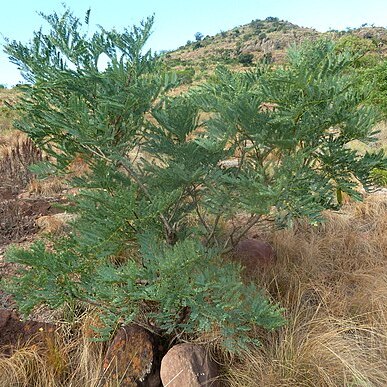A branched shrub or small tree 1-3(6) m high, occasionally as small as 0.3 m, but then the stems distinctly woody and branched and the inflorescences normally borne on lateral shoots of the current season's growth; bark dark grey to reddish; young branchlets glabrous. Leaves glabrous or almost so: petiole 2.6-6.5 cm long; rhachis 3.6-4.5 cm long; pinnae (1)4-8(9) pairs; rhachillae 3.5-2.5 cm long; leaflets (9)12-23(32) pairs per pinna, 7-17 x 1.5-3.5(5) mm, narrowly oblanceolate to very narrowly elliptic or linear-oblong, usually glaucous, glabrous, base slightly asymmetric (less so than in E. elephantina), with the proximal side rounded to cuneate, apex symmetric, obtuse to rounded, generally mucronate, lateral nerves and veins prominent or not. Racemes axillary, solitary or fascicled, often on lateral shoots, 5-10(2.5) cm long (including the peduncle), glabrous. Flowers yellowish-white, on pedicels up to 2 mm long, pedicels articulated near the middle, with minute reddish glands at the base of the pedicels. Calyx campanulate, up to 2.5 mm long, 5-toothed, the teeth up to 0.75 mm long, glabrous. Petals shortly united basally, up to 4.5 mm long, 1 mm wide, linear-oblong, inflexed apically, glabrous. Stamens free among themselves, slightly adnate to the corolla basally; filaments up to 5 mm long; anthers up to 0.75 mm long, with a deciduous apical gland. Ovary up to 2 mm long, glabrous. Pods dark brown to reddish-brown, 10-19(28) x 2.5-4 cm, straight or slightly curved, oblong, compressed, sometimes prominently transversely venose, at maturity the valves separating from the persistent margins, the outer layer of the pod-wall peeling off the inner layer, the layers remaining intact or breaking up irregularly. Seeds ±9-13 x 8-12 mm.
Leaves 7-18 cm. long (rhachis + petiole), glabrous or almost so when mature; pinnae (1)4-8 pairs; leaflets 9-32 pairs per pinna, 7-15 x 1·5-3·5(4·5) mm., narrowly oblanceolate to very narrowly elliptic or linear-oblong, glabrous, base slightly asymmetric (less so than in E. elephantina), with the proximal side rounded to cuneate, apex symmetric, obtuse to rounded, generally mucronate, lateral nerves and veins prominent or not.
A shrub or small tree. It can be 30 cm high or 6 m high. It can have several stems. It loses its leaves during the year. The bark is dark grey to red. The leaves are like acacia. They are twice compound. They have 4-8 pairs of pinnae and 12-36 pairs of leaflets. The leaflets are 7-17 mm by 2-3.5 mm. The flowers are in creamy white spikes. They are 5-10 cm long. The fruit is a flat woody pod 10-19 cm long by 2-4 cm wide.
Branched shrub or small tree, up to 6 m high. Leaves with 4-8 pairs of pinnae; leaflets only slightly asymmetrical basally with proximal side cuneate to slightly rounded, 1.5-3.5 mm wide. Pod oblong, 100-190 x 2.5-1.0 mm, compressed. Flowers yellowish white.
Shrub or small tree usually 1-6 m. high, occasionally as small as 0·3 m., but then with stems distinctly woody and branched and the inflorescences normally on lateral shoots of the current season; bark dark-grey to reddish; young branchlets glabrous.
Racemes 5-10(12) cm. long (including the peduncle), glabrous; minute reddish mealy glands present round the pedicel-bases.
Seeds c. 11-13 x 8-12 x 8 mm., the few seen irregular in shape.
Flowers variously described as cream or yellow.
Petals 3-4·5 mm. long.
Pods 10-19 x 2·5-4 cm.


